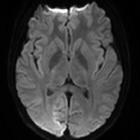POLG-related disorders

POLG-related disorders, or polymerase gamma-related disorders, describes a spectrum of genetic mitochondrial disorders with overlapping phenotypes.
The four main POLG-related disorders are:
- Alpers syndrome
- ataxia neuropathy spectrum (ANS)
- progressive external ophthalmoplegia (PEO)
- myoclonic epilepsy myopathy sensory ataxia (MEMSA)
Epidemiology
POLG-related disorders are very rare, with the most common subtype having an incidence of approximately one in 50,000 people .
Clinical presentation
The clinical presentation and onset of symptoms is very varied and largely depends on the phenotype that is expressed, which are summarized below. It should be noted that despite being divided into different phenotypes, there is a significant amount of overlap between them . A family history of mitochondrial disorders is often not noted .
Alpers syndrome
Also known as Alpers-Huttenlocher syndrome, and previously as progressive cerebral poliodystrophy, this is the most well-studied POLG-related disorder . It describes a childhood-onset progressive and severe encephalopathy with patients presenting with the classic triad of :
- psychomotor regression
- intractable seizures: partial (including epilepsia partialis continua) or generalized (including both convulsive and non-convulsive status epilepticus), often myoclonus and visual phenomena are described
- liver failure: generally precedes neurological features
For a full discussion, see: Alpers syndrome.
A childhood-onset form also exists, known as ‘childhood myocerebrohepatopathy spectrum (MCHS)’, which shares the same clinical presentation . In some patients Alpers syndrome may exist without liver failure, and the term ‘Alpers-like encephalopathy’ is used in these cases .
Ataxia neuropathy spectrum
Characterized by sensory or cerebellar ataxia and peripheral sensory neuropathy, although approximately two-thirds also develop epilepsy, often myoclonic, and half also develop ophthalmoplegia .
For a full discussion, see: ataxia neuropathy spectrum.
Progressive external ophthalmoplegia
Progressive external ophthalmoplegia (PEO) is characterized by progressive weakness of the extraocular muscles causing ophthalmoparesis and ptosis . It has autosomal dominant and autosomal recessive forms, each with distinct clinical presentations:
- autosomal dominant (adPEO): PEO with systemic involvement such as generalized myopathy, sensorineural hearing loss, Parkinsonism, ataxia, neuropathy, ovarian failure, and psychiatric symptoms
- autosomal recessive (arPEO): PEO generally without systemic involvement
For a full discussion, see: progressive external ophthalmoplegia.
Myoclonic epilepsy myopathy sensory ataxia
As its name described, myoclonic epilepsy myopathy sensory ataxia (MEMSA) is characterized by myoclonic epilepsy, myopathy, and ataxia. Of note, and unlike autosomal dominant progressive external ophthalmoplegia, these patients have no ophthalmoplegia .
For a full discussion, see: myoclonic epilepsy myopathy sensory ataxia.
Pathology
Mitochondria contain their own DNA (mtDNA) and their replication and repair is mediated primarily by DNA polymerase γ . DNA polymerase γ replicates this mtDNA continuously and independent of cell division, but does need a catalytic accessory subunit in order to function properly .
Genetics
The polymerase gamma (POLG) gene (POLG1) is located on the long arm of chromosome 15 and encodes for DNA polymerase γ, while the POLG2 gene, located on the long arm of chromosome 17, encodes for its catalytic accessory subunit . Damage to either of these genes result in uncontrolled mtDNA defects which result in a very varied clinical phenotype that changes across a patient’s lifespan .
Generally, mutations to POLG2 only result in autosomal dominant PEO, while mutations to POLG1 result in any other POLG-related disorder, all of which are inherited in an autosomal recessive pattern .
Radiographic features
Radiographic features of POLG-related disorders are not well-described beyond case series-level evidence whereby neuroimaging features of POLG-related disorders featuring epilepsy, such as Alpers syndrome, are most commonly described .
See individual articles for details of radiographic features.
Treatment and prognosis
Treatment is complex and non-curative, with focuses on family education, genetic counseling, symptom management, and supportive care .
Prognosis depends on the specific POLG-related disorder present and the degree of epilepsy control and multiorgan dysfunction, but is generally poor .

